Factors Affecting the Community Acceptance of Onshore Wind Farms: A Case Study of the Zhongying Wind Farm in Eastern China
Abstract
:1. Introduction
- What factors influence community acceptance of wind farms?
- How do these factors interact and form the background of community acceptance?
- What are the possible recommendations for improving community acceptance of wind farms through the optimization of planning procedures?
2. Methodology
3. Results
3.1. Category of Factors
3.2. Variance Analysis
3.3. Regression Analysis
3.3.1. Information
3.3.2. Compensation
3.3.3. Visual Angle
3.3.4. Noise
3.4. Environmental Impacts and Accompanied Annoyances
4. Discussion
4.1. Significant Variables in the Regression Model
4.2. Location-Related Factors
4.3. Demographic Factors
4.4. Environmental Impact Factors
4.5. Public Participation Factors
4.6. Limitation in This Research
5. Conclusions and Recommendations
Author Contributions
Funding
Acknowledgments
Conflicts of Interest
Appendix A. Questionnaire for Inhabitants around Zhongying Wind Farm in Ningbo, China
- Your age: (1) <18 (2) 18–30 (3) 30–40 (4) 40–50 (5) 50–60 (6) >60
- Your gender: (1) Male (2) Female
- What is your marital status? (1) Single (2) Married (3) Divorced (4) Widowed (5) Other
- Your educational background: (1) Primary school or lower (2) Middle school (3) High school (4) Professional academy (5) University or higher (6) Other
- Your job:____________________________________________________________________________
- How long do you live here? (1) <1 year (2) 1–5 years (3) 5–10 years (4) 10–20 years (5) >20 years
- Do you know about Zhongying Wind Farm Project? (1) I know clearly (2) I know about it (3) Not very familiar (4) I don’t know it at all
- The distance from your residence to the nearest wind turbine: (1) <500 m (2) 500–1000 m (3) 1000–3000 m (4) >3000 m
- Visibility of the wind turbines from your residence: (1) Invisible (2) Small part visible (3) Most visible (4) Fully exposed
- Does the environmental impact (noise, flicker) of the wind farm affect your life? (1) Not at all (2) It has a certain impact (3) Medium impact (4) Unbearable impact (5) Other thoughts ____________________________________________________________________________________
- How long you are affected by the wind farm each day? (1) None at all (2) <1 h (3) 1–3 h (4) 3–5 h (5) 5–8 h (6) >8 h
- What is your opinion on the visual impact of the wind farm? (1) No impact (2) Positive impact (3) Have negative effects (4) Not clear
- Does the wind farm project have compensation measures for surrounding residents? (1) No compensation (2) Yes ____________________________________________________ (3) Unknown
- Your opinions and suggestions on wind farm planning:________________________________________________________________________________________________________________________________________________________________________________________________________________________________________________________________________________________________________________________________________________
References
- GWEC (Global Wind Energy Council). Global Wind Report 2019; GWEC: Brussels, Belgium, 2020.
- GWEC (Global Wind Energy Council). Global Wind Energy Outlook 2016; GWEC: Brussels, Belgium, 2016.
- REN21. REN21-2019 Global Status Report; REN21: Paris, France, 2019; ISBN 978-3-9818911-7-1. [Google Scholar]
- CNREC. China Energy Policy Newsletter-Boosting Renewable Energy as Part of China’s Energy Revolution, June 2020; CNREC: Beijing, China, 2020.
- Diógenes, J.R.F.; Claro, J.; Rodrigues, J.C.; Loureiro, M.V. Barriers to onshore wind energy implementation: A systematic review. Energy Res. Soc. Sci. 2020, 60, 1–33. [Google Scholar] [CrossRef]
- Li, L.; Ren, X.; Yang, Y.; Zhang, P.; Chen, X. Analysis and recommendations for onshore wind power policies in China. Renew. Sustain. Energy Rev. 2018, 82, 156–167. [Google Scholar] [CrossRef]
- Ye, Q.; Jiaqi, L.; Mengye, Z. Wind Curtailment in China and Lessons from the United States; China’s Energy in Transition Series: Beijing, China, 2017. [Google Scholar]
- Davidson, M. Regulatory and Technical Barriers to Wind Energy Integration In Northeast China; Massachusetts Institute of Technology: Cambridge, MA, USA, 2014. [Google Scholar]
- Dai, J.; Yang, X.; Wen, L. Development of wind power industry in China: A comprehensive assessment. Renew. Sustain. Energy Rev. 2018, 97, 156–164. [Google Scholar] [CrossRef]
- Wang, H.; Kitson, L.; Bridle, R.; Gass, P.; Attwood, C. Wind Power in China: A Cautionary Tale; International Institute for Sustainable Development: Winnipeg, MB, Canada, 2016. [Google Scholar]
- Zhao, Z.Y.; Yan, H.; Zuo, J.; Tian, Y.X.; Zillante, G. A critical review of factors affecting the wind power generation industry in China. Renew. Sustain. Energy Rev. 2013, 19, 499–508. [Google Scholar] [CrossRef]
- Li, T.; Liu, P.; Li, Z. A multi-period and multi-regional modeling and optimization approach to energy infrastructure planning at a transient stage: A case study of China. Comput. Chem. Eng. 2020, 133, 106673. [Google Scholar] [CrossRef]
- CNEA. The 13th Wind Energy Five-Year Plan (2016–2020); CNEA (Chinese National Energy Administration): Beijing, China, 2016.
- Guan, J. Lessons from German On-shore wind farm planning. In Proceedings of the Journal of Physics: Conference Series, Hamburg, Germany, 25–28 September 2018; Volume 1102. [Google Scholar]
- Roddis, P.; Carver, S.; Dallimer, M.; Norman, P.; Ziv, G. The role of community acceptance in planning outcomes for onshore wind and solar farms: An energy justice analysis. Appl. Energy 2018, 226, 353–364. [Google Scholar] [CrossRef]
- Hammami, S.M.; Chtourou, S.; Triki, A. Identifying the determinants of community acceptance of renewable energy technologies: The case study of a wind energy project from Tunisia. Renew. Sustain. Energy Rev. 2016, 54, 151–160. [Google Scholar] [CrossRef]
- Eichhorn, M.; Masurowski, F.; Becker, R.; Thrän, D. Wind energy expansion scenarios—A spatial sustainability assessment. Energy 2019, 180, 367–375. [Google Scholar] [CrossRef]
- Wüstenhagen, R.; Wolsink, M.; Bürer, M.J. Social acceptance of renewable energy innovation: An introduction to the concept. Energy Policy 2007, 35, 2683–2691. [Google Scholar] [CrossRef] [Green Version]
- Dear, M. Understanding and overcoming the NIMBY syndrome. J. Am. Plan. Assoc. 1992, 58, 288–300. [Google Scholar] [CrossRef]
- Wolsink, M. Wind power and the NIMBY-myth: Institutional capacity and the limited significance of public support. Renew. Energy 2000, 21, 49–64. [Google Scholar] [CrossRef]
- Wolsink, M. Planning of renewables schemes: Deliberative and fair decision-making on landscape issues instead of reproachful accusations of non-cooperation. Energy Policy 2007, 35, 2692–2704. [Google Scholar] [CrossRef]
- Swofford, J.; Slattery, M. Public attitudes of wind energy in Texas: Local communities in close proximity to wind farms and their effect on decision-making. Energy Policy 2010, 38, 2508–2519. [Google Scholar] [CrossRef]
- Petrova, M.A. NIMBYism revisited: Public acceptance of wind energy in the United States. Wiley Interdiscip. Rev. Clim. Chang. 2013, 4, 575–601. [Google Scholar] [CrossRef]
- Oxford English Dictionary NIMBYism. Available online: https://www.oed.com/view/Entry/245895?redirectedFrom=NIMBY#eid (accessed on 24 August 2020).
- Burningham, K.; Barnett, J.; Thrush, D. The Limitations of the NIMBY Concept for Understanding Public Engagement with Renewable Energy Technologies: A Literature Review; University of Manchester: Manchester, UK, 2006. [Google Scholar]
- Rand, J.; Hoen, B. Thirty years of North American wind energy acceptance research: What have we learned? Energy Res. Soc. Sci. 2017, 29, 135–148. [Google Scholar] [CrossRef] [Green Version]
- Heras-Saizarbitoria, I.; Cilleruelo, E.; Zamanillo, I. Public acceptance of renewables and the media: An analysis of the Spanish PV solar experience. Renew. Sustain. Energy Rev. 2011, 15, 4685–4696. [Google Scholar] [CrossRef]
- Owens, S.; Driffill, L. How to change attitudes and behaviours in the context of energy. Energy Policy 2008, 36, 4412–4418. [Google Scholar] [CrossRef]
- Geraint, E.; Gianluca, F. The Social Acceptance of Wind Energy: JRC Science for Policy Report; European Commission: Brusseles, Belgium, 2016. [Google Scholar]
- Carlman, I. Wind energy potential in Sweden: The importance of non-technical factors. Pap. Present. Int. Symp. Wind Energy Syst. 1982, 21, 335–348. [Google Scholar]
- Wolsink, M. The research agenda on social acceptance of distributed generation in smart grids: Renewable as common pool resources. Renew. Sustain. Energy Rev. 2012, 16, 822–835. [Google Scholar] [CrossRef]
- Petrova, M.A. From NIMBY to acceptance: Towards a novel frmawork for organizing and interpreting community concerns. Renew. Energy 2016, 86, 1280–1294. [Google Scholar] [CrossRef]
- Simcock, N. Procedural justice and the implementation of community wind energy projects: A case study from South Yorkshire, UK. Land Use Policy 2016, 59, 467–477. [Google Scholar] [CrossRef] [Green Version]
- Yuan, X.; Zuo, J.; Huisingh, D. Social acceptance of wind power: A case study of Shandong Province, China. J. Clean. Prod. 2015, 92, 168–178. [Google Scholar] [CrossRef]
- Guo, Y.; Ru, P.; Su, J.; Anadon, L.D. Not in my backyard, but not far away from me: Local acceptance of wind power in China. Energy 2015, 82, 722–733. [Google Scholar] [CrossRef] [Green Version]
- Jobert, A.; Laborgne, P.; Mimler, S. Local acceptance of wind energy: Factors of success identified in French and German case studies. Energy Policy 2007, 35, 2751–2760. [Google Scholar] [CrossRef]
- Jones, C.R.; Eiser, J.R. Understanding “local” opposition to wind development in the UK: How big is a backyard? Energy Policy 2010, 38, 3106–3117. [Google Scholar] [CrossRef] [Green Version]
- Friedl, C.; Reichl, J. Realizing energy infrastructure projects-A qualitative empirical analysis of local practices to address social acceptance. Energy Policy 2016, 89, 184–193. [Google Scholar] [CrossRef]
- Caporale, D.; de Lucia, C. Social acceptance of on-shore wind energy in Apulia Region (Southern Italy). Renew. Sustain. Energy Rev. 2015, 52, 1378–1390. [Google Scholar] [CrossRef]
- Painuly, J.P. Barriers to renewable energy penetration: A framework for analysis. Renew. Energy 2001, 24, 73–89. [Google Scholar] [CrossRef]
- Musall, F.D.; Kuik, O. Local acceptance of renewable energy-A case study from southeast Germany. Energy Policy 2011, 39, 3252–3260. [Google Scholar] [CrossRef]
- Ntanos, S.; Kyriakopoulos, G.; Chalikias, M.; Arabatzis, G.; Skordoulis, M.; Galatsidas, S.; Drosos, D. A social assessment of the usage of renewable energy sources and its contribution to life quality: The case of an attica urban area in Greece. Sustainability 2018, 10, 1414. [Google Scholar] [CrossRef] [Green Version]
- Devine-Wright, P. Reconsidering public acceptance of renewable energy technologies: A critical review. In Delivering a Low Carbon Electricity System: Technologies, Economics and Policy; Jamasb, T., Grubb, M., Pollitt, M., Eds.; Cambridge University Press: London, UK, 2007. [Google Scholar]
- Leiren, M.D.; Aakre, S.; Linnerud, K.; Julsrud, T.E.; di Nucci, M.R.; Krug, M. community acceptance of wind energy developments: Experience from wind energy scarce regions in Europe. Sustainability 2020, 12, 1754. [Google Scholar] [CrossRef] [Green Version]
- Wolsink, M. 303 wind power implementation: The nature of public attitudes: Equity and fairness instead of “backyard motives. Renew. Sustain. Energy Rev. 2007, 11, 1188–1207. [Google Scholar] [CrossRef]
- Manyoky, M.; Wissen Hayek, U.; Pieren, R.; Heutschi, K.; Grêt-Regamey, A. Evaluating a visual-acoustic simulation for wind park assessment. Landsc. Urban Plan. 2016, 153, 180–197. [Google Scholar] [CrossRef] [Green Version]
- Tabassum, A.; Premalatha, M.; Abbasi, T.; Abbasi, S.A. Wind energy: Increasing deployment, rising environmental concerns. Renew. Sustain. Energy Rev. 2014, 31, 270–288. [Google Scholar] [CrossRef]
- Wang, S.; Wang, S. Impacts of wind energy on environment: A review. Renew. Sustain. Energy Rev. 2015, 49, 437–443. [Google Scholar] [CrossRef]
- Kokologos, D.; Tsitoura, I.; Kouloumpis, V.; Tsoutsos, T. Visual impact assessment method for wind parks: A case study in Crete. Land Use Policy 2014, 39, 110–120. [Google Scholar] [CrossRef]
- Cornwall Council. An Assessment of the Landscape Sensitivity to On-Shore Wind Energy and Large-Scale Photovoltaic Development in Cornwall; Cornwall Council: Cornwall, UK, 2013.
- Beauchamp, G.; Armstrong, W.; Buchan, N. Visual Representation of Windfarms Good Practice Guidance; SNH Commissioned Report: Dochgarroch, UK; Edinburgh, UK, 2006. [Google Scholar]
- Maehr, A.M.; Watts, G.R.; Hanratty, J.; Talmi, D. Emotional response to images of wind turbines: A psychophysiological study of their visual impact on the landscape. Landsc. Urban Plan. 2015, 142, 71–79. [Google Scholar] [CrossRef] [Green Version]
- Land Use Consultants. Brechfa Forest East Wind Farm Volume 1: Environmental Statement; Land Use Consultants: London, UK, 2011. [Google Scholar]
- Katsaprakakis, D.A. A review of the environmental and human impacts from wind parks. A case study for the Prefecture of Lasithi, Crete. Renew. Sustain. Energy Rev. 2012, 16, 2850–2863. [Google Scholar] [CrossRef]
- Herbrandson, C.; Messing, R. Public Health Impacts of Wind Turbines; Minnesota Department of Health Environmental Health Division: St Paul, MN, USA, 2009. [Google Scholar]
- Walker, C.; Baxter, J.; Mason, S.; Luginaah, I.; Ouellette, D. Wind energy development and perceived real estate values in Ontario, Canada. AIMS Energy 2014, 2, 424–442. [Google Scholar] [CrossRef]
- Jones, C.R.; Orr, B.J.; Eiser, J.R. When is enough, enough? Identifying predictors of capacity estimates for onshore wind-power development in a region of the UK. Energy Policy 2011, 39, 4563–4577. [Google Scholar] [CrossRef] [Green Version]
- Hübner, G.; Pohl, J. Mehr Abstand–Mehr Akzeptanz? Ein umweltpsychologischer Studienvergleich; Fachagentur Windenergie an Land: Berlin, Germany, 2015. [Google Scholar]
- Groth, T.M.; Vogt, C. Residents’ perceptions of wind turbines: An analysis of two townships in Michigan. Energy Policy 2014, 65, 251–260. [Google Scholar] [CrossRef]
- Enevoldsen, P.; Sovacool, B.K. Examining the social acceptance of wind energy: Practical guidelines for onshore wind project development in France. Renew. Sustain. Energy Rev. 2016, 53, 178–184. [Google Scholar] [CrossRef]
- Bassi, S.; Bowen, A.; Fankhauser, S. The Case for and Against Onshore Wind Energy in the UK; Grantham Research Institute on Climate Change and Environment Policy Brief: London, UK, 2012. [Google Scholar]
- Devlin, E. Factors Affecting Public Acceptance of Wind Turbines in Sweden; Lunds University: Lund, Sweden, 2002. [Google Scholar]
- Frate, C.A.; Brannstrom, C. How do stakeholders perceive barriers to large-scale wind power diffusion? A q-method case study from Ceará State, Brazil. Energies 2019, 12, 2063. [Google Scholar] [CrossRef] [Green Version]
- Pedersen, E.; van den Berg, F.; Bakker, R.; Bouma, J. Response to noise from modern wind farms in The Netherlands. J. Acoust. Soc. Am. 2009, 126, 634–643. [Google Scholar] [CrossRef] [PubMed] [Green Version]
- Scottish Natural Heritage. Visual Representation of Wind Farms; Scottish Natural Heritage: Inverness, UK, 2017; pp. 1–53. [Google Scholar]
- Van Renterghem, T.; Bockstael, A.; de Weirt, V.; Botteldooren, D. Annoyance, detection and recognition of wind turbine noise. Sci. Total Environ. 2013, 456, 333–345. [Google Scholar] [CrossRef] [Green Version]
- Arezes, P.M.; Bernardo, C.A.; Ribeiro, E.; Dias, H. Implications of wind power generation: Exposure to wind turbine noise. Proc. Soc. Behav. Sci. 2014, 109, 390–395. [Google Scholar] [CrossRef] [Green Version]
- Pedersen, E.; Waye, K.P. Wind turbine noise, annoyance and self-reported health and well-being in different living environments. Occup. Environ. Med. 2007, 64, 480–486. [Google Scholar] [CrossRef] [Green Version]
- Jones, C.R.; Eiser, J.R. Identifying predictors of attitudes towards local onshore wind development with reference to an English case study. Energy Policy 2009, 37, 4604–4614. [Google Scholar] [CrossRef] [Green Version]
- Bolin, K.; Bluhm, G.; Eriksson, G.; Nilsson, M.E. Infrasound and low frequency noise from wind turbines: Exposure and health effects. Environ. Res. Lett. 2011, 6, 1–6. [Google Scholar] [CrossRef] [Green Version]
- Shang, H.; Bishop, I.D. Visual thresholds for detection, rrcognition and visual impact in landscape settings. J. Environ. Psychol. 2000, 20, 125–140. [Google Scholar] [CrossRef] [Green Version]
- Lantz, E.; Flowers, L. Social Acceptance “Winning Hearts and Minds” State-Of-The-Art Report; The International Energy Agency: Geneva, Switzerland, 2009. [Google Scholar]
- Molnarova, K.; Sklenicka, P.; Stiborek, J.; Svobodova, K.; Salek, M.; Brabec, E. Visual preferences for wind turbines: Location, numbers and respondent characteristics. Appl. Energy 2012, 92, 269–278. [Google Scholar] [CrossRef] [Green Version]
- Strumse, E. Demographic differences in the visual preferences for agrarian landscapes in Western Norway. J. Environ. Psychol. 1996, 16, 17–31. [Google Scholar] [CrossRef]
- Li, H.; Guo, S.; Cui, L.; Yan, J.; Liu, J.; Wang, B. Review of renewable energy industry in Beijing: Development status, obstacles and proposals. Renew. Sustain. Energy Rev. 2015, 43, 711–725. [Google Scholar] [CrossRef]
- Devine-Wright, P. Energy citizenship: Psychological aspects of evolution in sustainable energy technologies. In Governing Technology for Sustainability; Murphy, J., Ed.; Earthscan: London, UK, 2007; pp. 63–88. ISBN 9781844073450. [Google Scholar]
- Devine-Wright, P. Local aspects of UK renewable energy development:Exploring public beliefs and policy implications. Local Environ. 2005, 10, 57–69. [Google Scholar] [CrossRef] [Green Version]
- Jami, A.A.N.; Walsh, P.R. The role of public participation in identifying stakeholder synergies in wind power project development: The case study of Ontario, Canada. Renew. Energy 2014, 68, 194–202. [Google Scholar] [CrossRef]
- Lane, M.B. Public participation in planning: An intellectual history. Aust. Geogr. 2005, 36, 283–299. [Google Scholar] [CrossRef]
- Firestone, J.; Bates, A.; Knapp, L.A. See me, feel me, touch me, heal me: Wind turbines, culture, landscapes, and sound impressions. Land Use Policy 2015, 46, 241–249. [Google Scholar] [CrossRef] [Green Version]
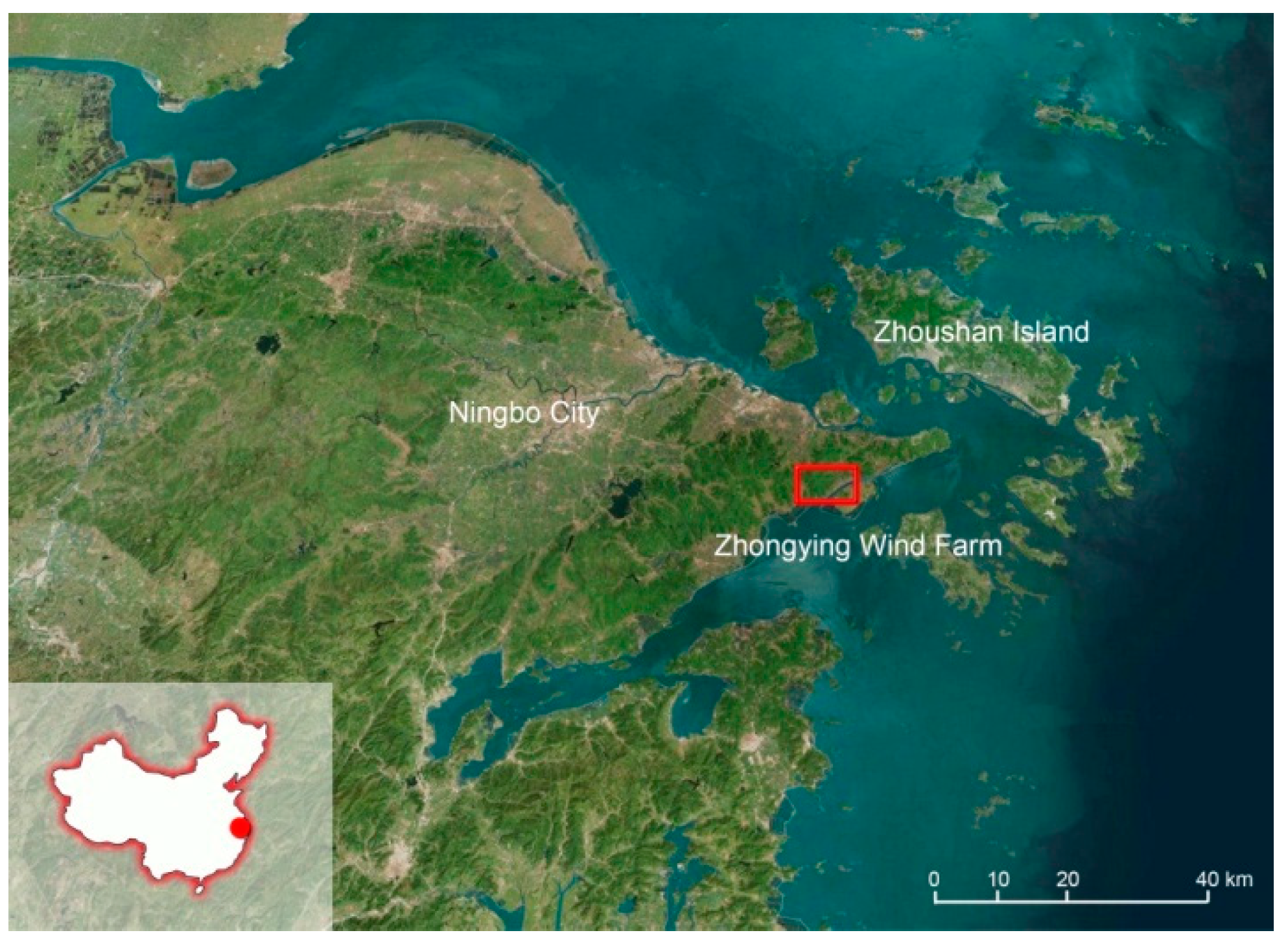
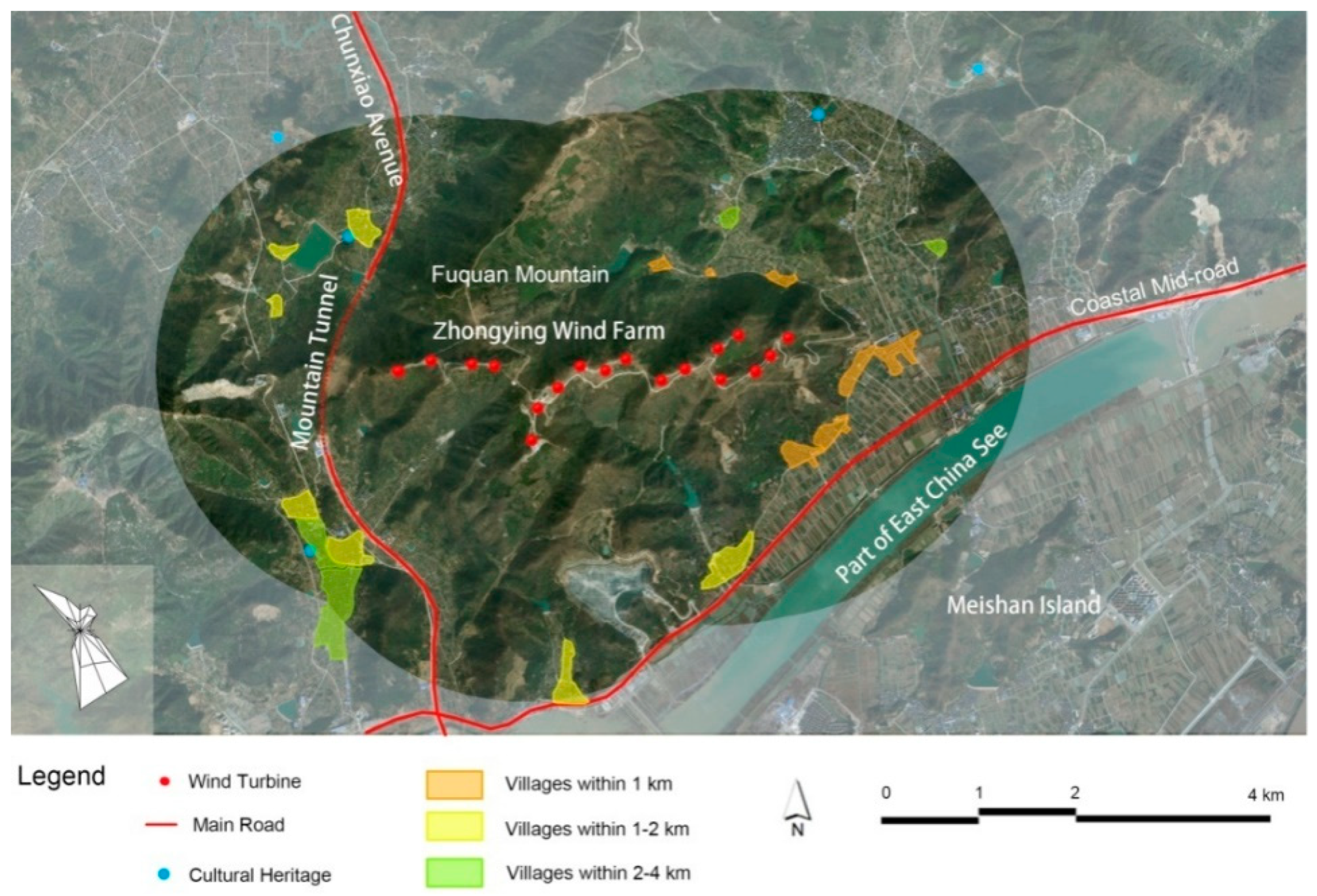
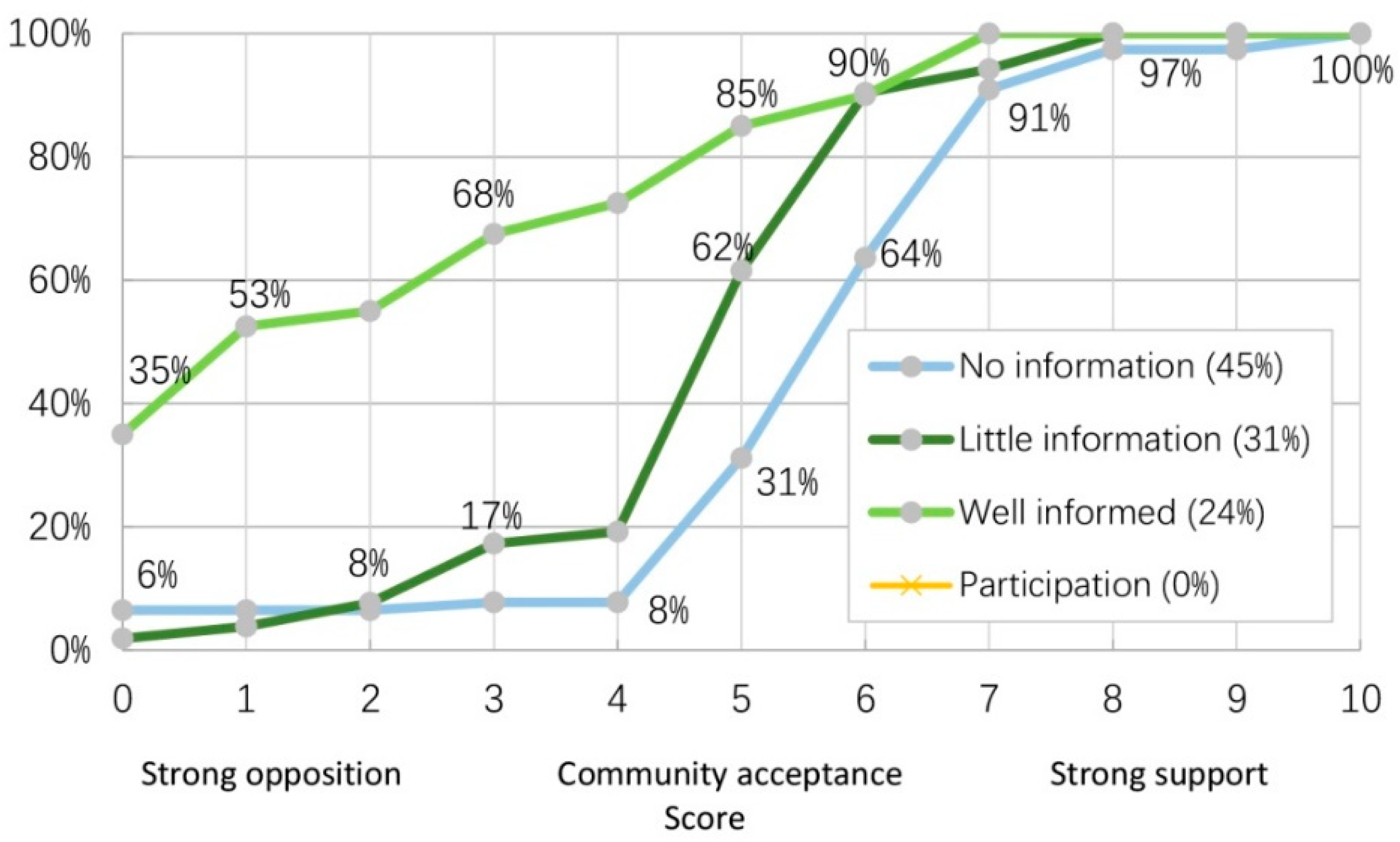
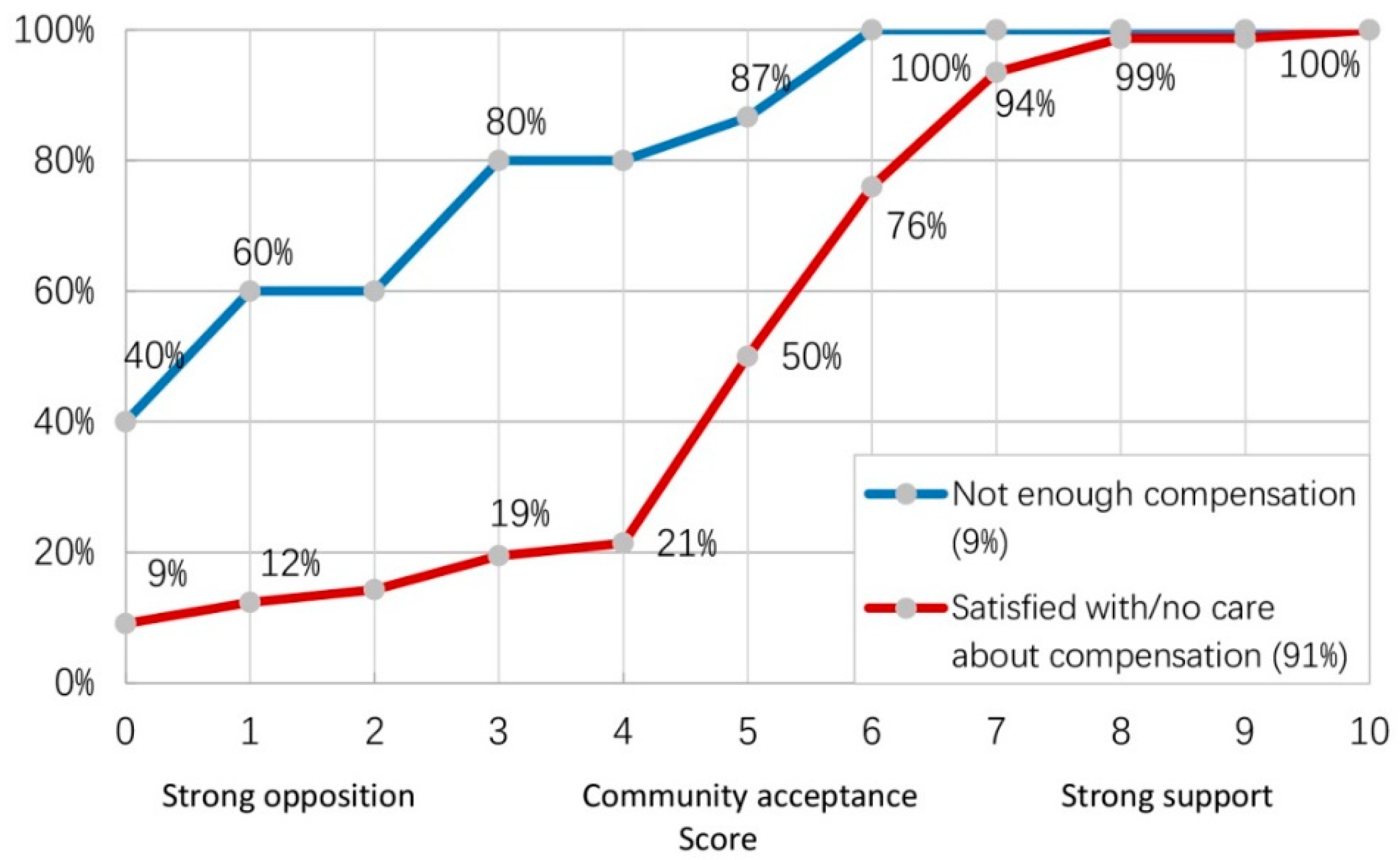

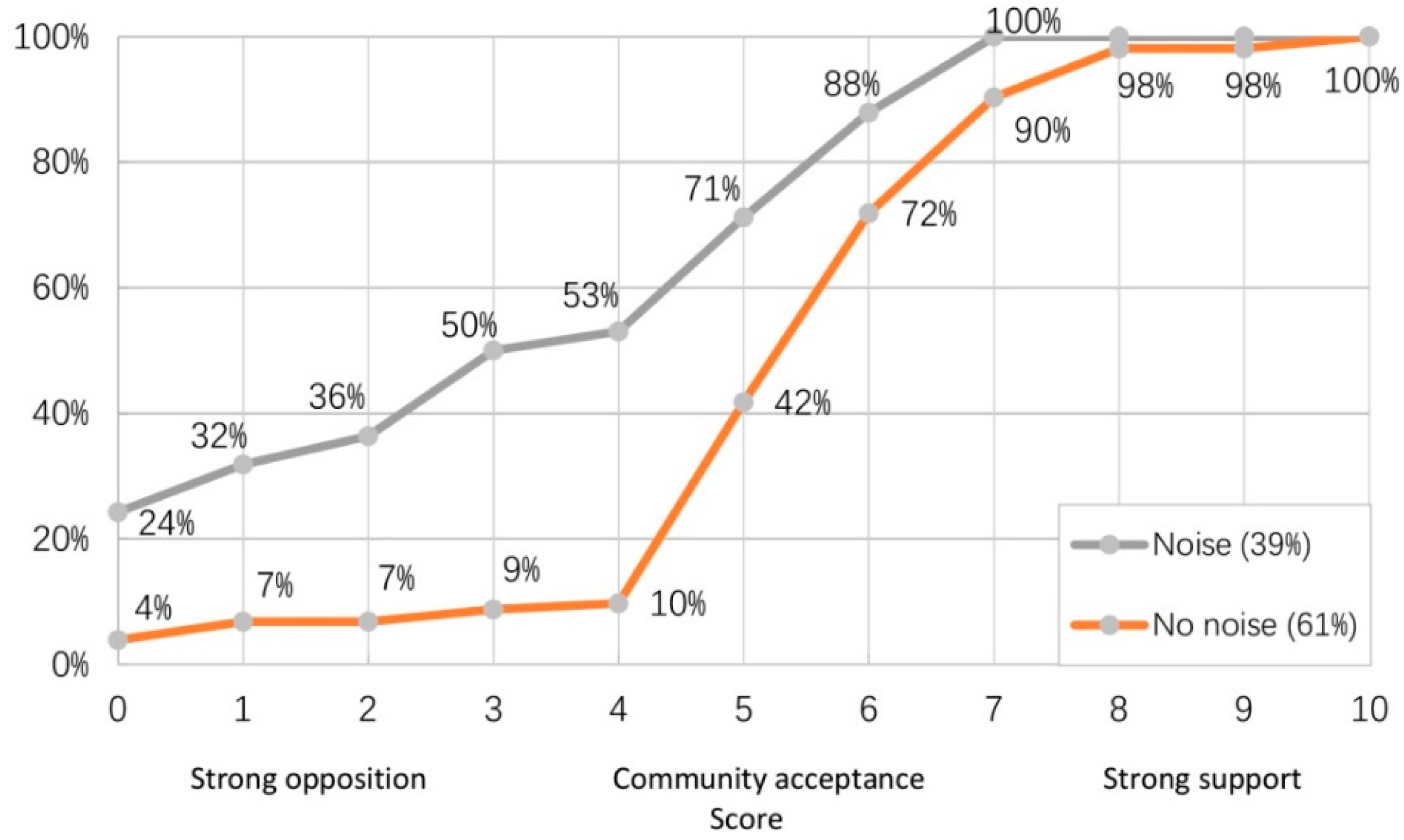
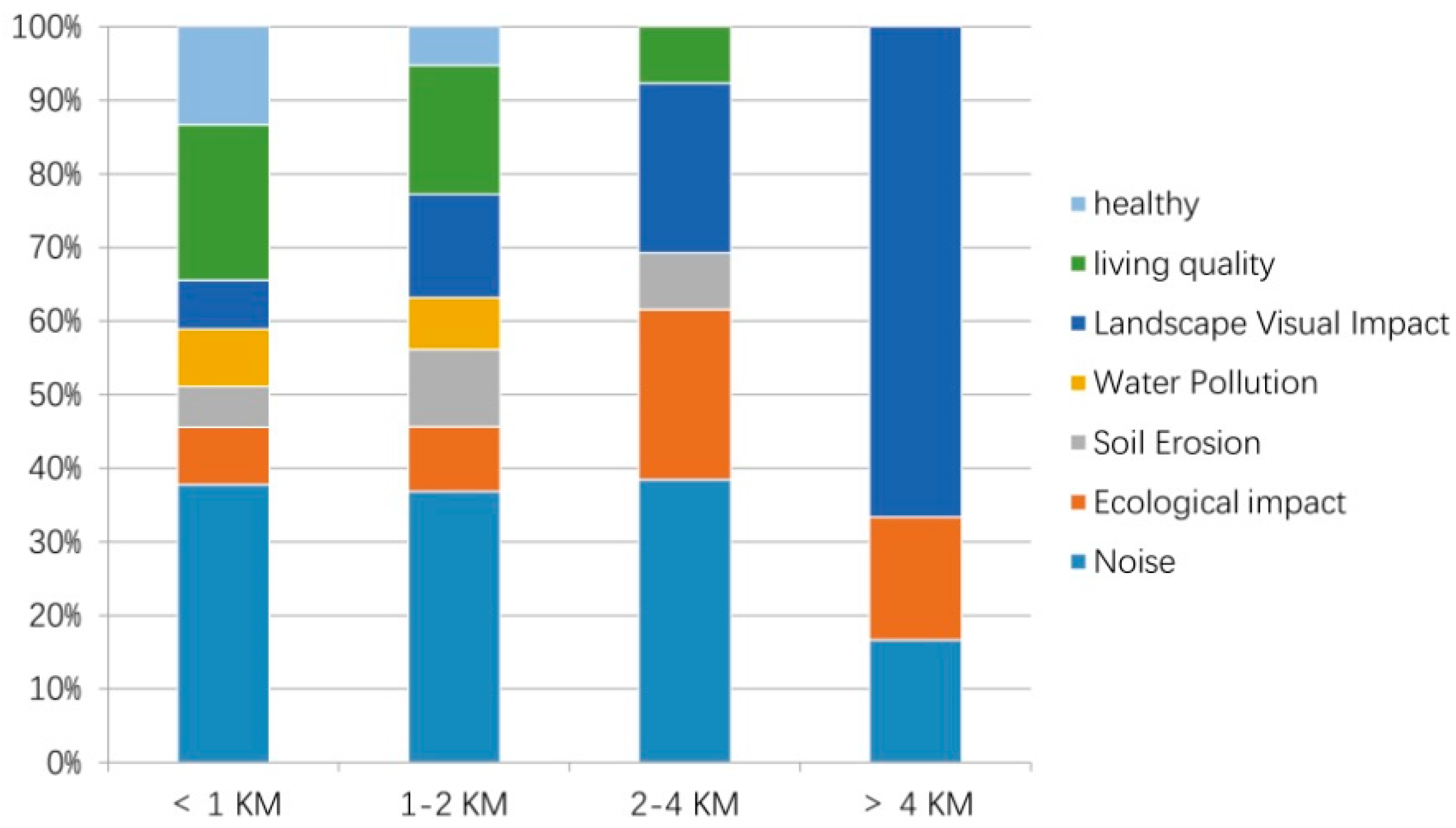
| Factors | Description of Factors |
|---|---|
| Location-Related Factors | |
| Distance | Direct distance from the settlement to the nearest wind turbine |
| Visual angle | The angle between the front views wind turbines and the sight of people |
| Original environment | Original environment in the locality |
| Demographic Factors | |
| Age | The age of interviewees |
| Gender | The gender of interviewees |
| Family | The marital status of interviewees |
| Education | Received educational level of interviewees |
| Length of residence | How many years interviewees live in the community |
| Occupation | The job of the interviewees |
| Environmental Impact Factors | |
| Visibility | The proportion of visible wind turbines |
| Noise | Whether perceived noise or not |
| Soil & water pollution | Soil and water pollution in the locality of the wind turbines |
| Public Participation Factors | |
| Information | Are the interviewees well informed before the project approved? |
| Compensation | Whether the interviewees are satisfied with the compensation or not? |
| Groups | Distance to the Nearest Wind Turbine | Source of Respondents | Distance (m) | Number of Interviewees | Population | |
|---|---|---|---|---|---|---|
| 1. Very near | <1 km | Shangwang Village | 710 | 49 | 7 | 379 |
| Xiayang Village | 790 | 10 | 293 | |||
| Daotou Village | 570 | 7 | 776 | |||
| Aokou Village | 670 | 6 | 60 | |||
| Taipingao Village | 600 | 8 | 12 | |||
| Aodi Village | 900 | 11 | 55 | |||
| 2. Near | 1–2 km | Shanglongquan Village | 1300 | 46 | 6 | 339 |
| Wangjialu Village | 1500 | 10 | 118 | |||
| Dongshan Village | 1200 | 4 | 92 | |||
| Shangchemen Village | 1500 | 3 | 421 | |||
| Kunting Village | 1700 | 7 | 850 | |||
| Ganao Village | 1650 | 7 | 327 | |||
| Caojiatang Village | 1680 | 5 | 466 | |||
| Dongyuan Village | 1600 | 4 | 254 | |||
| 3. Mid-distance | 2–4 km | Shangliu Village | 2200–2800 | 37 | 14 | 590 |
| Guichi Village | 2300–3200 | 15 | 595 | |||
| Xiawan Village | 2800–3800 | 8 | 162 | |||
| 4. Remote distance | >4 km | Nearby residents | - | 37 | 6 | - |
| Passers | - | 23 | - | |||
| Tourists | - | 8 | - | |||
| Variables | Categories | F (ANOVA) | P (Significance) |
|---|---|---|---|
| Location-Related Variables | |||
| Distance | 1: < 1 km, 2: 1–2 km, 3: 2–4 km, 4: > 4 km. | 40.740 ** | 0.000 |
| Visual angle | 1: < 30°, 2: 30–45°, 3: 45–75°, 4: > 75°. | 10.482 ** | 0.000 |
| Original environment | 1: positive, 2: normal, 3: negative. | 0.112 | 0.894 |
| Demographic Variables | |||
| Age | 1: < 18, 2: 18–40, 3: 40–60, 4: > 60. | 13.364 ** | 0.000 |
| Gender | Male, female | 0.448 | 0.504 |
| Family | 1: single, 2: married, 3: widowed/divorced. | 6.283 * | 0.002 |
| Education | 1: primary school, 2: secondary school, 3: high school, 4: college/university. | 11.378 ** | 0.000 |
| Length of residence | 1: < 5, 2: 5–10, 3: 10–20, 4: > 20. | 10.876 ** | 0.000 |
| Occupation | 1: primary industry, 2: secondary industry, 3: tertiary industry, 4: civil servant. | 9.191 ** | 0.000 |
| Environmental Impact Variables | |||
| Visibility | 1: invisible, 2: partly visible, 3: most visible, 4: totally visible. | 27.331 ** | 0.000 |
| Noise | 1: yes, 0: no. | 41.478 ** | 0.000 |
| Soil & water pollution | 1: yes, 0: no. | 2.306 | 0.103 |
| Public Participation Variables | |||
| Information | 1: no, 2: little information, 3: well informed, 4: positively participated. | 39.671 ** | 0.000 |
| Compensation | 1: not enough compensation, 0: satisfied with/no care about compensation. | 26.897 ** | 0.000 |
| Independent Variable | Model 1 | Model 2 | Model 3 | Model 4 |
|---|---|---|---|---|
| Distance | 0.469 ** | 0.316 ** | 0.149 | 0.095 |
| Visual angle | −0.149 | −0.191 * | −0.189 * | −0.150 * |
| Age | −0.130 | −0.138 | −0.142 | |
| Family | −0.014 | 0.004 | 0.001 | |
| Education | 0.156 * | 0.117 | 0.117 | |
| Length of residence | −0.215 ** | −0.173 * | −0.091 | |
| Occupation | 0.082 | 0.080 | 0.053 | |
| Visibility | −0.185 * | −0.140 | ||
| Noise | −0.137 * | −0.123 * | ||
| Information | −0.213 ** | |||
| Compensation | −0.160 ** | |||
| Constant a | 3.052 | 5.657 | 7.925 | 8.438 |
| R2 | 0.334 | 0.496 | 0.525 | 0.576 |
| N | 169 | 169 | 169 | 169 |
© 2020 by the authors. Licensee MDPI, Basel, Switzerland. This article is an open access article distributed under the terms and conditions of the Creative Commons Attribution (CC BY) license (http://creativecommons.org/licenses/by/4.0/).
Share and Cite
Guan, J.; Zepp, H. Factors Affecting the Community Acceptance of Onshore Wind Farms: A Case Study of the Zhongying Wind Farm in Eastern China. Sustainability 2020, 12, 6894. https://doi.org/10.3390/su12176894
Guan J, Zepp H. Factors Affecting the Community Acceptance of Onshore Wind Farms: A Case Study of the Zhongying Wind Farm in Eastern China. Sustainability. 2020; 12(17):6894. https://doi.org/10.3390/su12176894
Chicago/Turabian StyleGuan, Jinjin, and Harald Zepp. 2020. "Factors Affecting the Community Acceptance of Onshore Wind Farms: A Case Study of the Zhongying Wind Farm in Eastern China" Sustainability 12, no. 17: 6894. https://doi.org/10.3390/su12176894




